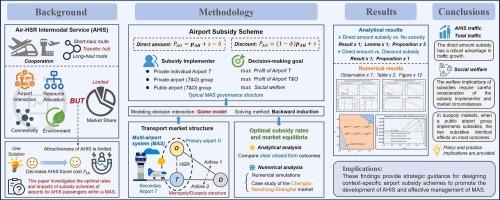多机场系统中空中高铁联运服务的机场补贴:直接金额vs折扣
IF 6.8
1区 工程技术
Q1 ECONOMICS
Transportation Research Part A-Policy and Practice
Pub Date : 2025-08-26
DOI:10.1016/j.tra.2025.104637
引用次数: 0
摘要
将航空运输与高铁相结合,提供空中高铁联运服务,可以协调运输资源,增强机场连通性,改善环境。本文建立了一个博弈模型,在考虑航空市场的垄断和双寡头结构以及典型的多机场系统治理结构(私人个体、私人集团和公共集团运营)的情况下,研究多机场系统(MAS)下机场补贴方案的最优费率和市场结果。我们分析了固定金额的直接补贴和依赖于AHIS价格的折扣补贴。分析结果表明,与不补贴相比,直接补贴增加了AHIS价格、AHIS流量和总流量,并持续提高垄断市场的消费者剩余和双寡头市场的社会福利。其对二级机场利润和机场系统总利润的积极影响取决于私有制和二级机场收费的提高。在双寡头市场中,当公共机场集团实施补贴时,折扣补贴比直接金额补贴产生更高的AHIS价格和运营商利润,但减少了二级机场的利润,对其他结果的影响相同。数值模拟和成都-南充-上海市场的案例研究表明,直接补贴在交通量增长方面具有强大的优势,而补贴的福利影响需要仔细考虑补贴实施人和市场环境。这些研究结果为设计符合具体情况的机场补贴计划提供了战略指导,以促进AHIS的发展和MAS的有效管理。本文章由计算机程序翻译,如有差异,请以英文原文为准。

Airport subsidy for air-HSR intermodal service in a multi-airport system: Direct amount vs. discount
Integrating air transport and high-speed rail (HSR) to provide air-HSR intermodal services (AHIS) can coordinate transport resources, enhance airport connectivity, and improve the environment. This paper develops a game model to investigate the optimal rates and market outcomes of airport subsidy schemes for AHIS passengers within a multi-airport system (MAS), considering monopoly and duopoly structures in the airline market as well as typical MAS governance structures (private individual, private group, and public group operations). We analyze a direct amount subsidy with a fixed amount of money and a discount subsidy dependent on AHIS prices. Our analytical findings show that, compared with no subsidy, the direct amount subsidy increases the AHIS price, AHIS traffic and total traffic, and consistently enhances consumer surplus in monopoly markets and social welfare in duopoly markets. Its positive impacts on the secondary airport's profit and the airport system's total profit are conditional on private ownership and higher secondary airport charges. In duopoly markets, when a public airport group implements subsidies, the discount subsidy yields a higher AHIS price and operator profit but reduces the secondary airport's profit compared to the direct amount subsidy, with identical effects on other outcomes. Numerical simulations and a case study of the Chengdu-Nanchong-Shanghai market suggest that the direct amount subsidy has a robust advantage in traffic growth, while the welfare implications of subsidies require careful consideration of the subsidy implementer and market circumstances. These findings provide strategic guidance for designing context-specific airport subsidy schemes to promote the development of AHIS and effective management of MAS.
求助全文
通过发布文献求助,成功后即可免费获取论文全文。
去求助
来源期刊
CiteScore
13.20
自引率
7.80%
发文量
257
审稿时长
9.8 months
期刊介绍:
Transportation Research: Part A contains papers of general interest in all passenger and freight transportation modes: policy analysis, formulation and evaluation; planning; interaction with the political, socioeconomic and physical environment; design, management and evaluation of transportation systems. Topics are approached from any discipline or perspective: economics, engineering, sociology, psychology, etc. Case studies, survey and expository papers are included, as are articles which contribute to unification of the field, or to an understanding of the comparative aspects of different systems. Papers which assess the scope for technological innovation within a social or political framework are also published. The journal is international, and places equal emphasis on the problems of industrialized and non-industrialized regions.
Part A''s aims and scope are complementary to Transportation Research Part B: Methodological, Part C: Emerging Technologies and Part D: Transport and Environment. Part E: Logistics and Transportation Review. Part F: Traffic Psychology and Behaviour. The complete set forms the most cohesive and comprehensive reference of current research in transportation science.

 求助内容:
求助内容: 应助结果提醒方式:
应助结果提醒方式:


